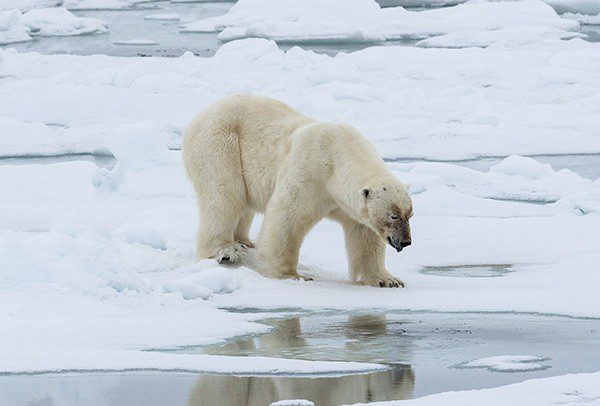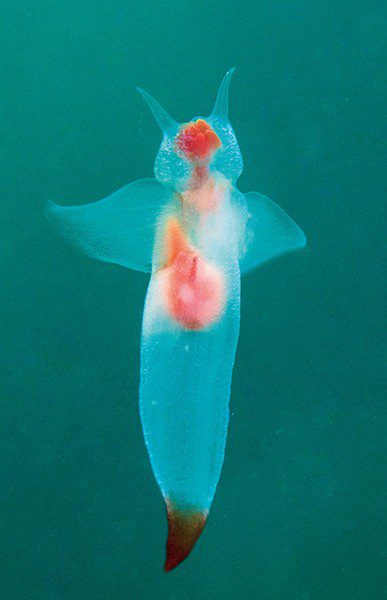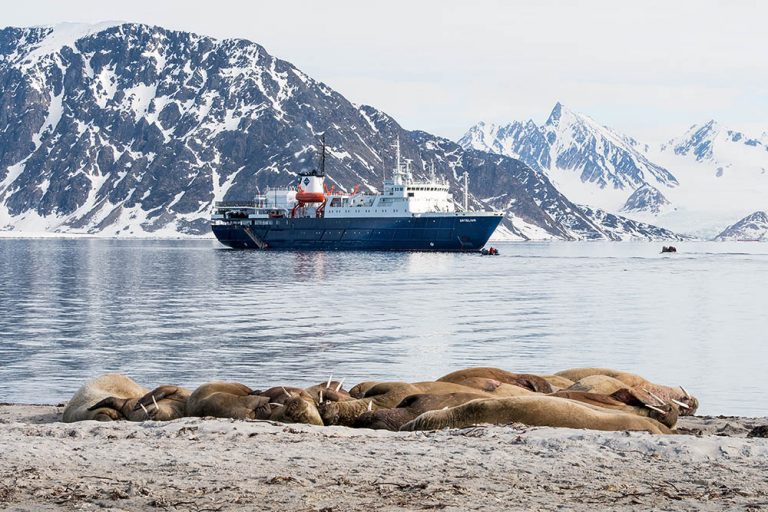ARCTIC DIVER
- 1) Onboard the Arctic Adventure
- 2) A Whale of a Surprise Post-Dive
- 3) Discovering the Arctic Wildlife
- 4) A Challenging Dive and Minke Whales
- 5) Nature and History of Svalbard
- 6) From Mining Town to Adventure Gateway: Longyearbyen
- 7) The Voyage Begins: Boarding the Ortelius
- 8) Testing the Waters: The Check-Out Dive
- 9) A Humbling Encounter with a Polar Bear
- 10) Adjusting the Itinerary: Confronting the Arctic Challenge
- 11) Dining with Polar Bears: A Unique Arctic Experience
- 12) Diving Beneath the Ice-Floes: An Unforgettable Experience
- 13) The Complex Ecosystem Under the Ice
- 14) Concluding the Expedition: The Final Dive
- 15) FACTFILE
Onboard the Arctic Adventure
Between continental Norway and the North Pole lies the Norwegian archipelago of Svalbard. Diving there has to take the form of an expedition – PETER DE MAAGT gets onboard
A Whale of a Surprise Post-Dive
Basking walruses, and behind them the Ortelius.
TURN AROUND! The sleek back and the typical tall sickle-shaped dorsal fin just broke the surface.
A minke whale! We had just finished a dive under Arctic pack-ice. The water was full of krill, small plankton and blooming algae, all of which made vis a challenge.
Discovering the Arctic Wildlife
Several sea angels tried to hide between the krill, but once you pointed your torch on them their orange-red coloration in the tail and horn-like organs in the mouth gave them away.
A Challenging Dive and Minke Whales
We tried to find Arctic cod hiding under the ice-floe, but the visibility was so limited that we failed. We decided to cut the dive short, because the frigid water was biting our faces and numbing our fingers.
Slightly miffed, we surfaced. The disappointment was short-lived, however as we realised that the large amount of krill also attracted the minke whales to the site. We saw repeated feeding dives by at least three of these giants.
Typically, minkes will exhale once at the surface and then dive for a longer period to feed. However, we had to wait only minutes before one would pop up again. We watched this magical show from very close by.
This was truly expedition diving – welcome to Svalbard!
Nature and History of Svalbard
The Svalbard archipelago is in the Arctic Ocean and the islands are known for their expanses of untouched nature. Historically, both whaling and trapping have been the major activities in Svalbard, but with growing insight sustainability has become a guiding principle.
Most of Svalbard has been declared either a nature reserve, park, sanctuary or otherwise protected area. It is home to pristine Arctic wilderness and unique wildlife in an environment that is both rough and fragile.
From Mining Town to Adventure Gateway: Longyearbyen
The beating heart of the islands and the main settlement is the town of Longyearbyen, located on the archipelago’s largest island, Spitsbergen. Longyearbyen is an old mining town with an eerie beauty. Everywhere you can see desolate remains of failed coal-mining. The wooden pylons of the old cableways that once brought down the coal are now silent witnesses of the past.
The Voyage Begins: Boarding the Ortelius
But Longyearbyen successfully managed to transform itself into a gateway for adventure tours visiting Svalbard and the Arctic in general. The people living there are a curious mix of adventure-seekers, scientists and environmentalists.
We were astonished to hear that today you cannot be born, grow old or die in Svalbard. There are no facilities for childbirth, or for the elderly (when you are no longer economically productive you are expected to leave) and there is no place to bury people. How bizarre!
But our visit to Longyearbyen lasts only half a day and we board the Ortelius, on which we will spend the week.
After all the mandatory briefings and preparing our kits for coldwater diving, we can finally go to sleep in anticipation of what is to come.
The sun never sets at this time of year, and it takes a while to adjust one’s internal clock.
Testing the Waters: The Check-Out Dive
In the early morning we wake up surrounded by a mystical fog, which means postponing the check-out dive. This dive would turn out to be essential, because many problems were identified and had to be resolved.
FOR EXAMPLE, one team-member found out the hard way that it is essential to close the zipper of your drysuit properly. His dive was very short; basically the time it takes to jump into the water and get back into the RIB.

As you can imagine, he needed some tolerance to banter. To makes things worse for him, a sketch of the event was posted on the pinboard in the bar area that same evening.
For the rest of the divers, there was reasonable visibility. A skate was seen on the bottom, and several nudibranchs in the kelp. A harbour seal played around the dive-boats as we finished our dive. Some of us then headed off for an exploratory walk.
Back on board, the Ortelius resumed its journey. It moved forward with a loud, relentless crunching and snapping sound as it pulverised the ice into fragments. When it is broken, the bow wake of the ship pushes it away, leaving a path of clear water to pass through.
The kittiwakes, with their high, nasal kitti-weeeik sound, accompanied the ship all day. They were hoping to catch polar cod, washed to the surface during the suction created when huge chunks of ice are overturned every now and again.
A Humbling Encounter with a Polar Bear
As soon as they spotted an unfortunate cod, they would get excited and squabble over every single fish between the cracks.
We saw large aggregations of seabirds, a mixture of gulls, gannets and puffins. Everywhere we looked we could see different types of auks, and one of us coined the name “penguin-wannabe”.
Auks are superficially similar to penguins with their black-and-white colouring, upright posture and some of their habits. They can “fly” under water but, despite being excellent swimmers and divers, they have an awkward gait.
The term “penguin” derives from an Arctic auk species – the great auk. It was a seabird and, like penguins in the Southern Hemisphere, flightless and very agile in the water but extremely clumsy on land.
Unfortunately, the great auk became extinct in 1844 as a result of human hunting and stealing of eggs.
Adjusting the Itinerary: Confronting the Arctic Challenge
AS THIS WAS A combined diving and polar-bear expedition, we spent the next day trying to find the bears. According to the sales brochure, the original plan had been to sail north of Spitsbergen, as far as the Sjuoyane islands, where there were excellent chances of spotting them, but we soon found ourselves in the midst of the ice floes.
The wind had blown pack-ice into our route, forming a dense ice-sheet. The Ortelius can withstand pack-ice but the RIBs would not be able to leave the ship, which meant that it would be impossible to dive or explore the land.
So the captain decided to deviate from the intended course and backtrack. Nature decided the route, making the trip a genuine expedition.
The brochure rang true: “This itinerary is for guidance only. Programmes may vary depending on local ice and weather conditions. Flexibility is paramount for expedition cruises.”
We did see polar bears, too. The expedition-leader spotted a tiny yellow dot moving slightly on the ice, along with several birds, and this was the sign for the captain to set course in that direction. He skilfully moved the Ortelius to within a few hundred metres of the bear, and we approached slowly to avoid disturbing it.
From a few hundred metres we had a great view and the chance to get good photos. The bear was a very large mature male, in good physical condition. It was standing next to the carcass of a bearded seal, of which only the skin and rib-cage remained intact.
The bones had been picked clean by the gulls. It was an impressive sight.
A little later, we saw a second, smaller, adult male. He showed no signs of fear and came close to the stern.
His tongue was constantly passing in and out of his mouth, suggesting that he was trying to make a better assessment of things with his sense of smell.
Dining with Polar Bears: A Unique Arctic Experience
As dinner was about to be served on the ship, I imagine that he was interested in a bite. What a way to end the day, with this delicious appetiser for treats to come.
Diving Beneath the Ice-Floes: An Unforgettable Experience
ANOTHER ATTEMPT WAS made to dive the pack-ice. The dive-leader managed to find a relatively small ice-floe, and because it was far enough away from the densely packed ice it was declared safe to dive.
Again we were greeted by a large amount of plankton and krill, so we decided to venture just beneath the edge of the ice. Because it was a relatively thin floe there was a very strange current beneath the surface, and although we felt as if we were circling the floe we came up at the same point where we had entered.
A common belief is that thin ice is bad, but our dive-guide explained that thinner floes can have a positive effect, as more light can penetrate to the depths at which nutrients are available, enabling organisms to grow.
As a result, more algae and bacteria can evolve in the water just beneath the ice sheet to feed bigger marine creatures.

The Complex Ecosystem Under the Ice
Some of this food is immediately consumed by animals living high up in the water-column. The heavier bits can sink to the bottom to feed seabed-dwellers. The algae are the food source for krill, small shrimp-like crustaceans that are the main food for most Arctic animals: seals, whales, penguins and other birds and fish.
The dive operation is kept simple: one or two dives a day are planned under thin ice, down along walls, from the shore or from the RIBs. Because of the remote location and lack of emergency facilities nearby, maximum depth is set at 20m.
One of the RIB dives was close to Danskegattet Likholmen Rock, an historic site because it’s near where the Swede Salomon August Andrée’s Arctic balloon expedition of 1897 set off in a bid to reach the North Pole. They failed, and all team-members perished. On the beach close to the site, you can still see the launch-site.
The seabed ranged from 5-50m and had a gradual incline. We entered in 5m of water and headed down to about 20m to see many creatures, big and small, among the kelp and in the water column.
Several inch-long sea-butterflies danced before our masks, moving in and out of camera focus and making us forget the extreme cold hitting our faces.
Returning to the Ortelius, which had re-positioned off Amsderdamoya, we visited the walrus haul at Smeerenburg. The group of walruses was sunbathing on the sand and lethargically raised their heads to look around at us once or twice.
Concluding the Expedition: The Final Dive
ONE OF THE BEST dives was the last. In the morning we saw several blue whales from the ship, a promising start to the day. In the afternoon the RIBs headed out to dive at Sagaskjeret, a small island in the bay at Alkornet.
The site had lots of kelp and the vis was impressive, but the water was cold at zero degrees. The underwater scenery was fabulous, with gullies and passes for us to swim through.
The walls were a clear white colour, like the white cliffs of Dover, while the seabed was covered with brown-grey rubble. Green kelp grew on the walls. This was ideal wide-angle scenery, but we were set up for macro, given the poor visibility of previous dives.
We still enjoyed the site immensely. The rocks were covered in life, with anemones and thousands of urchins living on their surface. After the dive, we went for a stroll on land, climbing up to the ridge of Alkornet to enjoy the beautiful scenery and take pictures of the passing reindeer.
For divers, this mind-blowing remote destination offers the opportunity for hard-to-match adventure and a chance to spend time diving with sea creatures rarely encountered elsewhere, such as winged snails and sea-angels.
Diving in polar waters is like no other diving; the combinations of very cold water, sunlight, krill, plankton and ice-floes creates a spectacle that is never the same from day to day.
Beside exploring beneath the ice-sheet, you can join onshore hikes and enjoy some of the best opportunities for close encounters with Arctic life on land. This combo ensures that you remember this as a once-in-a-lifetime experience.
FACTFILE
GETTING THERE> Daily flights to and from Svalbard, more in summer. Most are to and from Tromsø (two hours), but in summer you can fly direct from Oslo (three hours).
DIVING & ACCOMMODATION> You can book anything from small boats that take about 10 passengers for informal expedition cruises to large ice-strengthened ships or ice-breakers carrying 150 to 200 passengers. Both Ortelius and Plancius take 116 passengers in 53 cabins, oceanwide expeditions
WHEN TO GO> Svalbard lies far to the north yet has a relatively mild climate compared to other areas at this latitude. Average temperature in Longyearbyen ranges from -14°C in winter to 6°C in summer, which is the best time to visit – between May and September. During other months the archipelago freezes over.
MONEY> Norwegian krone, but on larger vessels you can pay in sterling, euros or US dollars. Svalbard has no VAT or special taxes on alcohol or tobacco and good prices on a wide range of products but goods taken from there to the mainland need Customs clearance on arrival, so there are limits to what can be purchased tax-free.
PRICES> The next 11-night Ortelius trip to the Arctic with scuba-diving as an option is in May 2018 and prices range from 3150 to 5750 euros pp depending on cabin-type. Wildfoot Travel also offers 9- or 10-night trips on Plancius in July 2018, from £3691-4200pp, wild foot travel
VISITOR Information> visit sval bard

